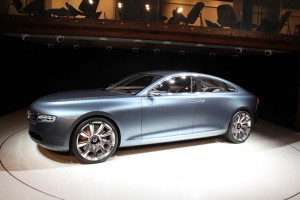
The Volvo Concept You hints at the direction the maker plans to take, including its shift to small 4-cylinder and battery-based powertrains.
It’s becoming increasingly difficult to call Volvo a Swedish car company. These days, most of its top management – headed by CEO Stefan Jacoby, a former Volkswagen executive – is German and it is now owned by China’s big Zhejiang Geely Holding Group.
Further confusing things, Volkswagen may soon have as much or more production capacity in China as it does in Europe, Jacoby confided in TheDetroitBureau.com during a conversation at the Beijing Motor Show.
Work is already underway to erect Volvo’s first Chinese assembly plant and, he confirmed, everything is in place to add a second Chinese factory. But now, he revealed, “We are considerating a powertrain plant in the greater Beijing region” that would likely meet most or all the engine and transmission needs for both those assembly lines.
Might Volvo even export engines from China back to Europe? Jacoby wouldn’t say. But it could be a lot simpler going forward considering the ostensibly Swedish manufacturer is planning to switch to a 4-cylinder engine strategy over the course of the next half decade, abandoning V-6s and -8s entirely.
Jacoby noted that Volvo sees plenty of opportunity in the booming Chinese market, especially after it begins production there – which would eliminate hefty tariffs on European imports. The goal is to push sales in the market to 200,000 annually by the “second half of the decade.” That would be roughly equal to what Volvo has been selling worldwide in recent years.
Though he said Volvo will remain “heavily dependent on the European market,” China is already helping “offset our losses in Europe,” Jacoby noted, adding that, “China is our second home now.”
That doesn’t mean Volvo will downplay the rest of the world. Jacoby said the Sino-Swedish maker plans to quadruple global sales by decade’s end, which would push things into the 800,000 range. Whether it can get there remains to be seen, of course, and there are plenty of skeptics.
Volvo floundered in its final years under former owner Ford Motor Co., and has been struggling to expand its corporate image beyond the safety sector. While it continues to come up with cutting edge technologies, like its City Safety, it is becoming more and more difficult to stay much ahead of competitors on the safety front.
That has spurred a move to a more passionate design language than the traditional Volvo box, as highlighted by new models like the S40 and the recent Concept You. Volvo is also pushing into a new powertrain direction, focusing on four-cylinder engines and battery power, with its first plug-in soon coming.
That could play especially well in China, where the central government has been strongly promoting alternative technologies as an answer to the endemic smog problems of cities like Beijing.
The government has also been pressing foreign makers and their Chinese partners (or parents, in the case of Volvo) to come up with new brands, such as Baojun, started by the General Motors-SAIC-Wuling consortium, and Venucia, newly launched by Nissan and Dongfeng, One appears to be in offing between Volvo and Geely.
But don’t expect that to minimize the role of Volvo, Jacoby asserted. “I do not see any Chinese brand that can come close to the image of European brands.”
Indeed, while Beijing rulers have been hoping that domestic brands – and these hybrid start-ups – would hold a 40% share of the Chinese market, they’re at barely 30% and actually lost share to European and other foreign brands last year.
